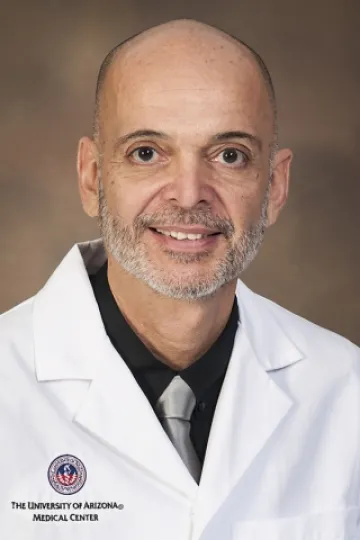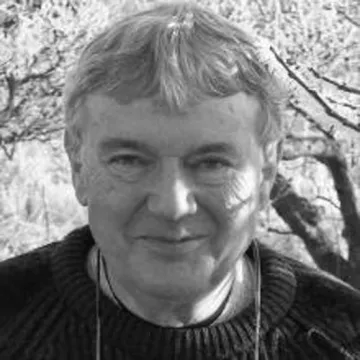The following faculty members are active researchers who are able to supervise dissertations and theses. Please click on the name of each member to learn more about them.
Admitted Ph.D. and M.S. students are encouraged to contact faculty directly to inquire about arranging a laboratory rotation. Rotations and laboratory placements are at the discretion of faculty and should be determined based on discussion of research interests and the goals of both the laboratory and the graduate student.
* indicates availability for 2025 - 2026 Ph.D. rotations and research placements
^ indicates availability for 2025 - 2026 M.S. research placements
- Last updated on 10/31/24 -

Program Affiliations: Psychology, Bio5 Institute, Physiological Sciences
Contact Information: (520) 626-1704, gene.alexander@arizona.edu
Research Interests: Neuroscience/Aging: brain-behavior relationships in the context of aging and age-related, neurodegenerative disease
- My research and academic interests focus on the study of brain-behavior relationships in the context of aging and age-related, neurodegenerative disease. I use neuroimaging techniques, including structural and functional magnetic resonance imaging (MRI) and positron emission tomography (PET), in combination with measures of cognition and behavior to address research questions on the effects of healthy aging and Alzheimer’s disease on the brain and on the mechanisms of human cognitive aging. A major focus of my research program includes the use of univariate and multivariate network analysis techniques with multiple neuroimaging methods and measures of neuropsychological function, health status, and genetic risk to understand how these factors interact to influence cognitive function as we age. My research also includes the application of these techniques to non-human animal models of aging and age-related disease. I direct the Brain Imaging, Behavior & Aging Lab in the Department of Psychology, have an appointment in the Evelyn F. McKnight Brain Institute, and direct the MRI Morphology Core of the Arizona Alzheimer’s Research Center.

Program Affiliations: Physiological Sciences, GIDP, Orthopedics
Website and Publications: https://ortho.arizona.edu/person/christopher-arellano-phd
Contact Information: arellanoc@arizona.edu
Research Interests: I have a broad interest in understanding the biomechanics, energetics, and balance of human and animal locomotion. Current projects focus on three main areas:
- Stability and Muscle-Tendon Mechanics: understand how the intrinsic properties of muscle and tendon contribute to stability in response to perturbations, with implications for the design of biologically inspired actuators.
- Self-Assistive Devices and Gait Rehabilitation: engineer and test devices that exploit the neural coupling behavior of the arms and legs during walking, with implications for improving rehabilitation gait training strategies for individuals with movement and balance disorders.
- Human Performance: advance our understanding of locomotion biomechanics and energetics and apply these insights to improve performance in the context of athletics, space-flight, elderly, etc.

Program Affiliations: Bio5 Institute, Physiology, Physiological Sciences
Website and Publications: Bailey Lab Homepage, Physiology Faculty Page
Contact Information: (520) 626-8299, ebailey@arizona.edu
Research Interests: Motor control, respiratory physiology, and hypertension
- The research focus in the Bailey laboratory is on the neural control of breathing in human and nonhuman mammals. The first work in this area assessed the role of pulmonary stretch receptors and central chemoreceptors in the genesis and relief of dyspnea or shortness of breath in healthy adults. These studies subsequently led to studies in the mammalian (rodent) airway that explored the modulation of upper airway muscles activities by chemical and pulmonary afferent feedback and the potential for selective electrical stimulation of the cranial nerve XII to alter airway geometry and volume (NIH/NIDCD RO3). Beginning in 2005, with the support of an NIH/NIDCD K23 I began work in neural control of upper airway muscles using tungsten microelectrodes to record from single motor units in adult human subjects. This work led in turn, to studies of regional (or segmental) muscle and motor unit activities in human subjects under volitional, state-dependent (i.e., wake/sleep) and chemoreceptor drives in health and disease (NIH/NIDCD RO1).
- On the basis of the experimental work in muscle and motor units we pursued additional lines of enquiry focused on clinical respiratory dysfunction in two specific populations a) infants at risk for SIDS and b) adults diagnosed with obstructive sleep apnea (OSA). Both lines of enquiry are highly innovative and have immediate diagnostic and clinical applications.
- One such line of enquiry explores the potential for a non-pharmacologic intervention daily to lower blood pressure and to improve sleep in patients diagnosed with mild-moderate obstructive sleep apnea. This training protocol shows promise as a cheap, effective and safe means of lowering blood pressure and improving autonomic-cardiovascular dysfunction in patients who are unwilling or unable to use the standard CPAP therapy.
- Support.
- Our work is supported by National Institutes of Health Grants (NIDCD: K23 007597; RO1 009587; Challenge Grant EB 10915) and by UA Gift Fund 560040 and by the American Heart Association (Grant in Aid GRNT 26700007).

Program Affiliations: Neuroscience GIDP, Physiology, Physiological Sciences
Website and Publications: Bao Lab Homepage, Publications
Contact Information: (520) 621-5680, sbao@arizona.edu
Research Interests: Neuroscience: Auditory processing in health and disease
- Hearing loss increases the risks of tinnitus, auditory processing deficit, dementia, anxiety and depression. We investigate the molecular, cellular, synaptic and circuit mechanisms underlying these hearing loss-related sensory and cognitive disorders.
- Perception is shaped by early experience. For example, exposure to native speech sounds improves our sensitivity to native speech contrasts, but can also reduce our sensitivity to foreign speech contrasts. How does experience alter neural circuits? How do the changes in neural circuits influence our perception? We address these questions in rodent models using a combination of electrophysiological, behavioral, and computational approaches.
- In certain neurological disorders, learning mechanisms are either impaired or operate under abnormal conditions. For example, while early acoustic exposure alters the auditory brain circuits in normal mice, such experience-dependent brain changes are absent in a mouse model of fragile X syndrome. Another example is homeostatic plasticity, which, under normal physiological conditions, keeps the neuronal firing rate in a range to optimally encode information. However, under the pathological condition of hearing loss, homeostatic plasticity may operate erroneously and cause tinnitus and hyperacusis. What are the cellular and molecular mechanisms underlying these brain disorders? Can we target those mechanisms for treatment of the disorders? We investigate these questions using a multifaceted approach that includes molecular biology, biochemistry, intracellular electrophysiology, ontogenetics, and behavioral techniques.

Program Affiliations: Bio5 Institute, Psychology, Physiological Sciences
Website and Publications: Psychology Faculty Homepage
Contact Information: (520) 626-2616, carol@nsma.arizona.edu
Research Interests: Neuroscience: Delineation of brain changes during late ontogeny and functional consequences on information processing
- Dr. Barnes' research interests involve the delineation of brain changes during late ontogeny (senescence) and the functional consequences of these changes on information processing and memory in older organisms. The major emphasis of the research in her lab has been an examination of the relationship between neurological change in the hippocampal formation of old rats and the accompanying decline of spatial learning-memory performance.
- The methods used include extra- and intracellular stimulation and recording in the in vitro hippocampal slice preparation and extracellular techniques in both the acute (anesthetized) and chronically prepared (unrestrained) animal. Some recent experiments have also been conducted using the new multiple single cell recording system developed here at the ARL Division of Neural Systems, Memory and Aging. Behavioral tests of spatial perception and memory (known to require an intact hippocampus for their proper performance) are routinely used in conjunction with the neurophysiological experiments, in order to most effectively assess brain-behavior relationships.
- The long-term goal of this work is a more complete understanding of the biological basis for the deterioration of cognitive function known to occur in the elderly. Such an understanding will hopefully lead to the development of neuropharmacological manipulations which much alleviate or delay neurophysiological and neuroanatomical changes known to occur normally with age, and which are responsible for the observed cognitive defects.

Program Affiliations: Physiology, Asthma and Airway Disease Research Center, Cell and Molecular Medicine, Immunobiology, Bio5 Institute, Physiological Sciences
Website and Publications: Physiology Faculty Page
Contact Information: (520) 626-2105, sboitano@arizona.edu
Research Interests: Asthma, Respiratory Cellular Physiology, Drug Discovery (Asthma and Pain)
- In collaboration with multiple laboratories, we have established a drug discovery program focused on novel targets and treatments for asthma (and pain). Our current focus is on protease-activated receptor-2 (PAR2). PAR2 is a G-protein-coupled receptor (GPCR) activated by proteases released from asthma-inducing pathogens including fungi (e.g., Alternata alternaria), house dust mites and cockroach, as well as endogenous proteases (e.g., mast cell tryptase and neutrophil elastase). Upon activation, PAR2 leads to intracellular Ca2+ concentration changes and b-arrestin-dependent mitogen activated protease kinase (MAPK) signaling. We have shown that PAR2 activation promotes inflammatory responses associated with allergic asthma (e.g., airway hyperresponsiveness (AHR), cytokine production, leukocyte infiltration, epithelial hyperplasia and excess mucus secretion). Further, we have demonstrated these events are dependent upon PAR2-dependent b-arrestin signaling. Importantly, we have developed unique PAR2 antagonists that target PAR2-dependent b-arrestin signaling and minimize allergen-induced asthma in animal models. We are working to improve and advance our PAR2 drug hits and leads to develop drugs that can limit allergen-induced asthma in humans.
- We work closely with our medicinal chemist colleague, Dr. Josef Vagner to develop potent and efficacious PAR2 antagonists. In our laboratory we use immortalized human bronchial cell cultures, primary mouse tracheal cell cultures and primary human bronchiole cell cultures with multiple cellular and molecular techniques to screen and evaluate PAR2 antagonists and capture a mechanistic understanding of PAR2 activation in airway epithelial cells. In collaboration with Dr. Julie Ledford we employ wild type, PAR2 knockout and ‘humanized’ PAR2 mouse models to evaluate antagonist potency and efficacy in pre-clinical allergen-induced asthma models. We have additional collaborations with Drs. Theodore J. Price and Gregory Dussor of the University of Texas, Dallas and Dr. Kathryn A. DeFea of PARMedics to evaluate the role of PAR2 in chronic pain and migraine.

Program Affiliations: Neuroscience, Physiological Sciences
Website and Publications: Cai Lab, Google Scholar Page, Neuroscience Faculty Page,
Contact Information: haijiangcai@arizona.edu
Research Interests:
- We are studying neural circuit mechanisms of animal behaviors in health and disease, with a focus on understanding how the neural circuits regulate eating and emotional behaviors such as fear, anxiety, and depression. We use multidisciplinary approaches including transgenic mice, optogenetics, chemogenetics, in vivo calcium imaging, various behavioral assays, brain slice electrophysiology, virus and non-virus based neuronal tracing, stereotaxic injection and surgery, immunohistology and microscopy imaging.

Program Affiliations: Pharmacogenomics, Pharmacology & Toxicology, Applied Biosciences, Cancer Biology, Pharmacology, Genetics
Website and Publications: Pharmacy Faculty Page
Contact Information: (520) 626-9126, qchen1@pharmacy.arizona.edu
Research Interests:
- Dr. Chen's laboratory has been focused on studying the molecular biology of oxidative stress. Ongoing research projects in her laboratory include 1) stress induced de novo protein synthesis for organ protection; 2) role of Nrf2 transcription factor in protection against cardiac injury; 3) function of Glucocorticoid Induced Leucine Zipper in the myocardium; 4) pharmacological agents that protect the heart from ischemic and chemotherapeutic injuries; and 5) biomarker discovery for predicting tissue injury due to oxidative stress.

Program Affiliations: Clinical and Translational Sciences, Physiological Sciences
Website and Publications: (520) 626-7221, Publications
Contact Information: azchignalia@arizona.edu
Research Interests: Cardiovascular diseases, Pulmonary Vascular Biology and Oxidative Signaling

Program Affiliations: Department of Nutrition, The Bio5 Institute, Physiological Sciences GIDP
Website and Publications: https://nutrition.cals.arizona.edu/, https://www.ncbi.nlm.nih.gov/pubmed/?term=Chilton+FH
Contact Information: (520) 621-5327, fchilton@arizona.edu
Research Interests:
- Dr. Chilton is widely recognized in academia and industry for his work on nutrition in the context of variation in the human genome and has been a pioneer in the areas of personalized or precision nutrition and wellness. He currently is the Director of the Precision Nutrition and Wellness Initiative. Specifically, his lab examines how genetic and epigenetic variations interact with human diets (especially the modern Western diet) to drive inflammation and inflammatory disorders (including cardiovascular disease and cancer), as well as psychiatric/developmental disorders (ADHD, autism spectrum disorder, and depression). These precision-, individualized- and population-based research approaches provide a wide range of opportunities to benefit human health and enhance wellness and disease prevention throughout the life span. Dr. Chilton currently has research grants, on-going studies, and collaborations in four major areas including: 1) Gene-diet interactions that drive racial/ethnic disparities; 2) Lifestyles and related molecular mechanisms that augment disease prevention and enhance wellness; and 3) Metabolomic and lipidomic analysis for the identification of molecular networks and related circulating and tissue biomarkers associated with human disease and aging.

Program Affiliations: Cellular and Molecular Medicine, Physiological Sciences, Director, iPS Cell Core
Website and Publications: Cellular & Molecular Medicine Faculty
Contact Information: Office: (520) 626-2347, Lab: (520) 626-3942, jchurko@arizona.edu
Research Interests: Heart development and cardiovascular disease
- His lab is located within the Sarver Heart Center, where he studies heart development and cardiovascular disease. Specifically, his lab combines systems biology, stem cell biology, cardiac biology, genetic engineering, and bioinformatics to understand the mechanisms leading to heart disease.

Program Affiliations: Department of Medicine, Division of Endocrinology, Department of Physiology, Physiological Sciences
Website and Publications: Department of Medicine Page, Physiology Faculty Page
Contact Information: (520) 626-9412, dcoletta@arizona.edu
Research Interests: Molecular and physiological basis of insulin resistance, which is a characteristic feature of a number of common metabolic diseases including type 2 diabetes mellitus, obesity and the insulin resistance syndrome.
- My laboratory combines state of the art techniques and in vivo clinical methods to identify and characterize genes/loci that influence this complex phenotype.

Program Affiliations: Arizona Biological and Biomedical Sciences, Biomedical Engineering, Biochemistry and Cellular & Molecular Biology, Physiological Sciences
Website and Publications: NCBI MyBibliography
Contact Information: (520) 621-1950, bcolson@arizona.edu
Research Interests: Cardiovascular Physiology: Deciphering the structural basis for cardiac and skeletal muscle contraction and genetic heart disease and muscle disorders at the molecular level
- Dr. Colson’s research interests include understanding the molecular motions of muscle proteins that finely-tune and regulate the heart’s contractile performance.
- The primary goal of his current research is to understand the relationship between the structural, biochemical, and physiological states in the mechanisms underlying cardiovascular dysfunction in genetic heart disease. These insights from the mechanistic studies in his lab are then used to design novel molecular therapies for heart failure and cardiovascular disease.
- Recent work in the Colson lab has focused on how genetic mutations and changes in post-translational modifications in myosin binding protein-C can cause the development of hypertrophic cardiomyopathy, the most common cause of sudden cardiac death in young people, and distal arthrogryposis, a skeletal muscle disorder of congenital joint contractures.
- Using site-directed spectroscopy, with high resolution in both space and time, Dr. Colson and his research team decipher the molecular dynamics in these muscle proteins, which are involved with controlling the strength and speed of cardiac muscle contraction. For these biophysical experiments, they attach fluorescent probes to track protein motions, orientation, and functional characteristics including protein binding and force development in the muscle cell. Similar state-of-the-art approaches are also used in his lab’s efforts for drug and small molecule discovery as novel heart failure therapies.

Program Affiliations: Psychology, Physiological Sciences
Website and Publications: Psychology Faculty Homepage
Contact Information: (520) 626-2615, scowen@arizona.edu
Research Interests: Neuroscience: Psychology

Program Affiliations: Animal and Biomedical Sciences, Bio5 Institute, Southwest Environmental Health Sciences Center, Arizona Cancer Center, Physiological Sciences
Contact Information: (520) 621-8082, zr.craig@arizona.edu
Research Interests: Reproductive Physiology, Toxicology
- Dr. Craig's research focuses on understanding how environmental exposures influence reproductive physiology and lead to infertility in humans and animals.

Program Affiliations: Department of Internal Medicine, Clinical Translational Sciences, Physiological Sciences GIDP
Website and Publications: lab website, publications
Contact Information: (602) 827-2982, zhiyudai@arizona.edu
Research Interests: Signaling pathways and molecular mechanism of pulmonary vascular diseases.
- My laboratory focuses on studying signaling pathways and molecular mechanism of pulmonary vascular diseases including pulmonary arterial hypertension. The lab employs the state-of-the art technologies including genetic lineage tracing, genetic depletion, genetic reporter, and CRISPR-mediated genomic editing, AAV, single cell RNA-sequencing as well as patient samples to study the molecular mechanisms of vascular disorder including pulmonary arterial hypertension and identify novel therapeutics for these devastating diseases.

Program Affiliations: Medical Pharmacology, Neuroscience, Bio5 Institute, Physiological Sciences
Contact Information: (951) 858-5720, davistp@U.arizona.edu
Research Interests: Stroke, Drug Transport, Blood-Brain Barrier
- Our laboratory continues its long-term CNS biodistribution research program, funded by NIH since 1981, by studying the mechanisms involved in delivering drugs across the blood-brain barrier to the C.N.S. during pathological disease states. We have recently discovered specific drug transporters which can be targeted to enhance delivery. We are also interested in studying the effect of hypoxia/aglycemia/inflammatory painon endothelial cell permeability and structure at the blood-brain barrier. We have recently shown that short-term hypoxia/aglycemia leads to significant alterations in permeability which can be reversed by specific calcium channel antagonists. This work has significant consequences to the study of stroke. Additionally, we have recently shown that peripheral pain has significant effects on BBB tight junction protein cytoarchitecture leading to variations in the delivery of analgesics to the CNS.

Program Affiliations: Physiology, Bio5 Institute, Physiological Sciences
Website and Publications: NCBI MyBibliography, Physiology Faculty Page
Contact Information: (520) 626-6425, delamere@arizona.edu
Research Interests: Glaucoma, Na,K-ATPase
- Na,K-ATPase regulation
- Aqueous humor secretion
- Na,K-ATPase-Src kinase interaction in lens epithelium
- Role of Na,K-ATPase alpha 2 in astrocytes

Program Affiliations: Physiology, Biomedical Engineering, Neuroscience, Bio5 Institute, Physiological Sciences
Website and Publications: Eggers Laboratory, NCBI MyBibliography, Physiology Faculty Page
Contact Information: (520) 626-7137, eeggers@u.arizona.edu
Research Interests: Diabetic Retinopathy, Neurophysiology, Visual Physiology, Neurodegenerative diseases
- The broad goal of research in our laboratory is to understand how synaptic inputs influence neuronal signaling and sensory signal processing in the healthy and diabetic retina. Currently we focus on how increased ambient light, dopamine and neuronal calcium handling modulate signaling in the retina and how this modulation changes in early diabetes. We use a combination of single cell and whole retinal electrophysiology and immunohistochemistry to identify targets for modulation that could lead to early treatments of diabetic eye disease. We are also interested in exploring the role of changes in the neurons, vasculature and glia in retina in other neurodegenerative diseases.

Program Affiliations: Neurology, Pharmacology, Physiological Sciences
Website and Publications: Neurology Faculty Homepage, NCBI MyBibliography
Contact Information: (520) 626-3927, tfalk@u.arizona.edu
Research Interests: For more than two decades, Dr. Falk's research has focused on cellular and rodent models to test novel therapies for Parkinson's disease treatment.
- Dr. Falk works on (1) novel pharmacological treatments for L-DOPA-induced dyskinesias, a major side effects in Parkinson's disease (PD) treatment, (2) testing novel neuroprotective (growth factor mediated) approaches for PD, and (3) development of blood-brain barrier penetrant glycopeptide drug candidates for the treatment of PD and neural injury.

Program Affiliations: Psychology, Physiological Sciences, Biomedical Engineering, Neuroscience and Applied Mathematics
Website and Publications: Fellous Laboratory, Fellous Homepage
Contact Information: (520) 626-2617, fellous@arizona.edu
Research Interests: Neural processes involved in complex spatial navigation and decision making. Learning and memory consolidation during sleep and neural bases of emotions.
- My research and academic interests focus on the neural computations involved in complex cognitive processes. We use computational (neural simulations) and neurophysiological tools (wireless recordings in behaving rats) to understand what makes complex decision possible. We focus on spatial navigation in very large environments and probabilistic decision making. We study the involvement of populations of neurons in the hippocampus and prefrontal cortex.

Program Affiliations: Physiology, Neuroscience, Bio5 Institute, Physiological Sciences
Website and Publications: Physiology Faculty Page
Contact Information: (520) 621-2203, fregosi@u.arizona.edu
Research Interests: Development of motoneurons; Motoneuron intrinsic properties; Synaptic transmission; Regulation of Breathing; Breathing-swallowing coordination
- We study the development of motoneuron intrinsic biophysical properties, gene expression patterns, and inhibitory and excitatory synaptic transmission, using brainstem respiratory neurons as a model. We are also interested in how these motoneuron properties differ according to the actions of the muscle that they innervate. Translational studies focus on how the normal developmental patterns are disrupted by exposure to toxins during fetal development. Studies are done on motoneurons of rodent neonates studied over the first three weeks of life. Techniques include whole cell patch clamp electrophysiology (both voltage and current clamp), extracellular recording from muscle or muscle nerves, immunohistochemistry, Western blot analysis, single cell RNA sequencing, in vivo measures of neonatal breathing using plethysmography, and in vivo measures of suckling and swallowing.

Program Affiliations: Physiology, Neuroscience, Biomedical Engineering, Bio5 Institute, Physiological Sciences
Website and Publications: Fuglevand Lab, Physiology Faculty Page
Contact Information: (520) 621-6983, fuglevan@u.arizona.edu
Research Interests: Neuroscience: Neurophysiology, Motor Control, Motor Neurons, Neuroprosthetics
- The broad goal of the work carried out in our laboratory is to understand how the mammalian nervous system controls the action of skeletal muscles to produce coordinated movements. We use a variety of experimental approaches, including computer modeling and simulation, single motor unit recording, and microneurographic methods to record and stimulate single sensory and motor axons. Our experiments address a range of topics from those related to how individual neurons integrate synaptic information to those associated with the development of new methods to restore movement and sensation in paralyzed individuals. Of particular emphasis at present are studies designed to characterize the functional organization of the corticospinal pathways that underlie the control of hand and finger movements.

Program Affiliations: Department of Medicine, Physiological Sciences, Cancer Biology, Nutritional Sciences and Wellness, Bio5 Institute, Arizona Cancer Center
Website and Publications: Cancer Center Profile, My NCBI
Contact Information: (520) 626-3242, jfunk@u.arizona.edu
Research Interests: Breast cancer bone metastases, bone and muscle loss with aging, dietary polyphenols.
- Exploring mechanistic basis of plant-derived dietary polyphenols that prevent age- and disease-related loss of bone and/or muscle
- Elucidating hormonal effects on cancer-niche that drive ER+ breast cancer progression in bone
- Hormonal regulation of obesity and breast cancer risk

Program Affiliations: Department of Pediatrics, Arizona Cancer Center, Institute for Clinical and Translational Science, Steele Children's Research Center, Diamond Children's Center, Horace W. Steele Endowed Chair in Pediatric Research, Physiological Sciences
Website and Publications: NCBI MyBibliography, Publications on PubMed, Faculty Home Page
Contact Information: (520) 626-5170, meckler@peds.arizona.edu
Research Interests: Pediatrics: Gastroenterology and Nutrition - Interests on Faculty Homepage:
- Autoimmune disorders (Inflammatory Bowel Disease (IBD), Crohn's disease, ulcerative colitis, eosinophilic esophagitis, eosinophilic gastroenteritis), the role curcumin plays in treating autoimmune disorders; intestinal ion transport of phosphate across the gastrointestinal tract; intestinal ion transport; regulation of digestive vesicular glutamate transporter
- Clinical Interests:
- Inflammatory Bowel Disease (IBD), Crohn's disease, ulcerative colitis, eosinophilic esophagitis, eosinophilic gastroenteritis, nutrition, autoimmune disorders

Program Affiliations: Physiology, Neuroscience, Bio5 Institute, Physiological Sciences
Website and Publications: Gothard Lab website
Contact Information: (520) 626-1448, kgothard@arizona.edu
Research Interests: Emotion, Interoception, Social Behavior
- The broad goal of the research in our laboratory is to understand the neurophysiological basis of emotion and social behaviors. We work with non-human primate models because they share with humans the most highly evolved cognitive, emotional, social, capabilities. We monitor and interpret neural activity recorded from multiple brain areas to determine the real-time dynamic interaction of all systems implicated in emotion regulation and the mechanisms by which emotional responses produce immediate behavioral effects. Current studies focus on adolescent brain development and the mechanism by which interoceptive signals bias social and emotional decision-making.

Program Affiliations: Animal & Biomedical Sciences - Research, Bio5 Institute, Physiological Sciences
Website and Publications: BIO5 Profile
Contact Information: (520) 626-5573, goyalr@arizona.edu
Research Interests: Epigenetic regulation of fetal and placental vascular development
- My major interests include epigenetic regulation of angiogenesis and vascular development. Angiogenesis plays a critical role in both physiological and pathological conditions. I am investigating various mechanisms involved in angiogenesis with development and aging of organisms and its role in organ development as well as cancers. My other area of investigation is involving adipose-derived stem cells and their usefulness in treating osteoarthritis, diabetes, stroke, traumatic brain injury, myocardial infarction, and spinal cord injuries following road traffic accidents.

Program Affiliations: Psychiatry, Medicine, Psychiary, Psychology, Sarver Heart Center, Physiological Sciences
Website and Publications: Michael Grandner, Psychiatry Faculty Page
Contact Information: (520) 626-6336, grandner@arizona.edu
Research Interests: Sleep and sleep-related behaviors related to cardiovascular disease, neurobehavioral functioning, mental health, and general well-being.
- Current research projects are funded by the National Heart, Lung, and Blood Institute (NHLBI) and the National Institute for Environmental Health Sciences (NIEHS). One study focuses on sleep patterns and how they relate to cardiometabolic disease risk and neurocognitive function. The other study is on social, environmental and behavioral factors and how they impact sleep. His methodologies include population-level surveys, computer-based geospatial analyses, home-based assessments of sleep and health, and in-laboratory studies. (Faculty Page)

Program Affiliations: Cellular and Molecular Biology, Physiology, Biomedical Engineering, Biological Physics, Physiological Sciences
Website and Publications: NCBI MyBibliography, Physiology Faculty Page
Contact Information: (520) 626-3641, granzier@arizona.edu
Research Interests: Cardiovascular Disease: Muscle, Cardiac, Cells, Mechanics, Titin, Contractility
- Muscle structure and function

Program Affiliations: Cellular and Molecular Medicine, Physiological Sciences
Website and Publications: Department of Medicine Faculty Homepage
Contact Information: (520) 621-0291, samharris@arizona.edu
Research Interests: Cardiovascular Disease: Cellular and Molecular Medicine

Program Affiliations: Cellular & Molecular Medicine, Arizona Biological and Biomedical Sciences, Physiological Sciences
Website and Publications: Hamilton Lab Website, PubMed
Contact Information: (520) 621-0303, shannahamilton@arizona.edu
Research Interests: Cardiovascular Physiology and Disease; Arrhythmias; Calcium Signaling; Oxidative Stress; Mitochondria
- Abnormal calcium handling in the heart is implicated in many cardiovascular diseases and contributes to cardiac arrhythmias and sudden cardiac death. The overarching goal of our laboratory is to decipher molecular mechanisms regulating calcium handling in the healthy and diseased heart. This will uncover new therapeutic approaches that we can test to prevent these arrhythmias and treat heart disease.
- We integrate a combination of confocal microscopy, electrophysiology, ex vivo whole heart optical mapping and gene editing approaches to study these mechanisms in multiple rodent models of cardiac diseases, from molecule-cell-organ-organism. This includes models of inherited heart disease (catecholaminergic polymorphic ventricular tachycardia; CPVT) and models of acquired heart disease (myocardial infarct, hypertrophy and heart failure, aging, diabetes, atrial arrhythmia).

Program Affiliations: Physiology, The McKnight Brain Institute, Sarver Heart Center, National Institute for Civil Discourse, Physiological Sciences
Website and Publications: Hay Laboratory, Physiology Faculty Page
Contact Information: (520) 626-7384, mhay@arizona.edu
Research Interests: Neuroscience/Hypertension: neurotransmitter, peptide and cellular mechanisms in central brain
- The primary focus of our laboratory is the understanding of how the brain regulates blood pressure.
- We study the neurotransmitter, peptide and cellular mechanisms in central brain nuclei that regulate sympathetic outflow and ultimately arterial blood pressure.
- Our ultimate goal is to identify potential new phamacotherapies that will improve the lives of individuals who suffer from cardiovascular disease.

Program Affiliations: Physiological Sciences
Website and Publications: Faculty website
Contact Information: mkaelberer@arizona.edu
Research Interests:
- My expertise is in sensory neurobiology and my research is focused on the role of the vagus nerve on gut sensory cell function. I have has studied the function of a neural circuit between vagal neurons and sensory enteroendocrine cells, or neuropods cells, in the gut. This work led to the publication of a first author paper in Science in 2018 that described an afferent neuroepithelial circuit between enteroendocrine cells and the vagus nerve. This synaptic connection is both necessary and sufficient to transduce a sugar stimulus from gut to brain. Furthermore, I found that sugar transduction differs depending on whether the sugar is caloric (i.e. sucrose) or non-caloric (i.e. sucralose). This difference helps the animal to distinguish which sugar to consume. This work opened an area of research at the center of disorders associated with food choice and consumption. My work is motivated by the belief that a comprehensive understanding of the afferent and efferent circuitry will lead to a better understanding of functional gastrointestinal disorders by identifying potential therapeutics.
Research Areas
- TBA
Research Overview

Program Affiliations: Pediatrics, Physiological Sciences, Cancer Biology, Immunobiology
Website and Publications: Katsanis/Simpson Lab Website, PubMed/NCBI, Google Scholar
Contact Information: (520) 626-7053, katsanis@peds.arizona.edu
Research Interests: Tumor and Transplant Immunology
- Professor of Pediatrics, Medicine, Immunobiology, Pathology and a member of the University of Arizona Cancer Center, Steele Children’s Research Center and the Bio5 Institute. I integrate my expertise in basic and translational research with clinical investigations and have over 35 years of research experience in the fields of tumor and transplant immunology.
- My laboratory currently focuses on: cell therapies in the setting of hematopoietic cell transplantation, balance between graft versus host disease and graft versus leukemia, chemo-immunotherapy and repurposing of drugs and delivery systems to enhance anti-tumor immune responses use of exercise as an adjuvant to improve cell therapies and anti-tumor responses.

Program Affiliations: Pediatrics, Bio5 Institute, Physiological Sciences
Website and Publications: Pediatrics Faculty Page
Contact Information: (520) 626-9687, pkiela@peds.arizona.edu
Research Interests: Pediatrics
- Therapeutic and pathophysiological aspects of Inflammatory Bowel Diseases.Crohn's disease (CD) and ulcerative colitis (UC) are two spontaneously relapsing, immunologically mediated disorders of the gastrointestinal tract which are characterized by intestinal inflammation and mucosal damage. These chronic, debilitating conditions characterized by abnormal and persistent immune response to intestinal commensal flora have multifactorial etiology with genetic predispositions and environmental factors contributing to the ultimate clinical manifestation. Despite recent advances in understanding the pathophysiology of IBD and development of new biological agents to treat active inflammation and to maintain remission, our knowledge and therapeutic options are still limited.Our laboratory, funded by the National Institute of Diabetes and Digestive and Kidney Diseases of the NIH, studies three aspects of IBD:
- Pre-clinical studies on the effectiveness and mechanism of action of curcumin (a natural non-specific inhibitor of NF-kappa-B) in mouse models of CD and UC (chemically induced colitis and spontaneous colitis in IL-10 or TCR-alpha knockout mice).
- The role of NHE3. the major intestinal Na+/H+ exchanger in the maintenance of epithelial integrity of the gut. and in modulation of the immune response in Inflammatory Bowel Diseases.
- The effects of acute and chronic colitis and inflammatory mediators on key players of systemic inorganic phosphate homeostasis and its contribution to osteopenia and osteoporosis frequently associated with IBD.

Program Affiliations: Physiology, Bio5 Institute, Biomedical Engineering, Molecular Cardiovascular Research Program, Physiological Sciences
Website and Publications: Physiology Faculty Page
Contact Information: (520) 626-6578, konhilas@arizona.edu
Research Interests: Cardiovascular Disease: Heart Disease, Impact of Diet, Exercise, Sex
- Gut microbiome and cardiac remodeling. Our lab has a long-standing interest in the ability of environmental factors, like diet, to impact cardiac disease. Advances in sequencing and bioinformatic technologies have allowed unprecedented characterization of the gut microbiome. We have discovered novel modifiers of the gut microbiome that protect against cardiac injury following ischemia.
- Sarcomere dynamics and crossbridge kinetics. Contractile perturbations downstream of Ca2+ binding to troponin C, the so-called sarcomere-controlled mechanisms, represent the earliest indicators of cardiovascular disease. We can now state the dynamics of cardiac contraction and relaxation during CVD are governed by downstream mechanisms, particularly the kinetics and energetics of the cross-bridge cycle. Our lab focuses on the contractile properties of the cardiomyocyte and how this changes with CVD.
- Sex dimorphisms in cardiac adaptation. Sex/gender differences exist in human cardiac disease resulting from many disease etoilogies including hypertension, myocardial infarction, and cardiomyopathies (HCM). We have adapted a novel model of menopause to uniquely address HCM and CVD, in general. As part of these studies, we became interested in a specific, energy-dependent signaling pathway, adenosine monophosphate-activated kinase (AMPK) demonstrating that AMPK regulates contractile function and energy cost of contraction.
- Predicting and mitigating postoperative surgical outcomes. (1) Cognitive impairment resulting from cardiac bypass surgery. Although treatment strategies for cardiovascular disease (CVD) are improving, coronary revascularization remains one of the most common interventional procedures. Following CABG surgery, cognitive impairment is reported in 50-75% of patients at discharge, 20-50% at 6 weeks and up to 40% at five years. Exciting new preclinical data from our group shows that systemic administration of Ang-(1-7) attenuates and even reverses CHF-induced cognitive impairment in mice. Our work has resulted in 2 patent applications (UA13-120 UA 14-167) and an IND application for the for Ang-(1-7) as a protective agent against CABG-induced cognitive impairment. (2) Predicting and mitigating postoperative new onset atrial fibrillation and cardiac remodeling. We have discovered a potential use for Human Amniotic Membranes for the prevention of postoperative (bypass surgery) outcomes. In human subjects, membrane placement during CABG preventative new onset postoperative atrial fibrillation. In mice, we prevented wall thinning post-myocardial infarction.

Program Affiliations: Medicine, Division of Endocrinology, Center for Disparities in Diabetes, Obesity & Metabolism; Physiological Sciences GIDP
Website and Publications: Langlais Lab, Quantitative Proteomics Laboratory, List of Publications
Contact Information: (520) 626-5909, langlais@arizona.edu
Research Interests: Proteins Involved in Insulin Signal Transduction and Insulin Resistance
- The role of insulin is to lower blood glucose levels by stimulating glucose uptake into muscle and adipose tissue. Resistance to insulin, a phenomenon directly involved in the pathogenesis of type 2 diabetes, remains to be understood. Basic research has yet to fully discover how insulin action is elicited. Research in the laboratory of Paul R. Langlais, Ph.D., focuses on the identification and characterization of proteins involved in insulin signal transduction and also tests whether the dysfunction of these proteins is involved in the pathogenesis of insulin resistance and type 2 diabetes.Dr. Langlais specializes in the use of mass spectrometry to perform proteomics, a technique that allows for large-scale quantitative analysis of protein abundances between different treatments. This approach led him to the discovery that CLIP-associating protein 2 (CLASP2) is responsive to insulin stimulation, and his now-published findings support the involvement of CLASP2 in insulin-stimulated glucose uptake. Current research is aimed at discovering the role of CLASP2 in insulin action, in addition to identifying new proteins previously unknown to function in this system.Dr. Langlais leads the University of Arizona College of Medicine Proteomics Laboratory, a collaborative environment for investigators at the University of Arizona and their colleagues to perform proteomic studies in their respective projects.

Program Affiliations: Cellular and Molecular Medicine, Physiological Sciences
Website and Publications: Department Faculty Page, Ledford lab
Contact Information: (520) 626-0276, jledford@arizona.edu
Research Interests: Asthma, respiratory infections, menopause and lung function, drug development

Program Affiliations: Nutritional Sciences, Cancer Biology, Bio5 Institute, Physiological Sciences
Contact Information: (520) 626-4517, limesank@u.arizona.edu
Research Interests: Cancer: Apoptosis, Salivary Acinar Cells, Radiation, Signaling
- Radiation therapy for head and neck cancer causes adverse secondary side effects in the normal salivary gland including xerostomia, oral mucositis, malnutrition, and increased oral infections. Although improvements have been made in targeting radiation treatment to the tumor, the salivary glands are often in close proximity to the treatment site. The significant destruction of the oral cavity following radiation therapy results in diminished quality of life and in some cases interruptions in cancer treatment schedules.
- My research program has its foundation in radiation-induced salivary gland dysfunction; mechanisms of damage, clinical prevention measures, and restoration therapies. Evidence suggests that salivary acinar function is compromised due to apoptosis induced by these treatments and temporary suppression of apoptotic events in salivary glands would have significant benefits to oral health. We utilize a number of techniques in my laboratory including: genetically engineered mouse models, real-time RT/PCR, immunoblotting, immunohistochemistry, primary cultures, siRNA transfections, irradiation, and procedures to quantitate salivary gland physiology.

Program Affiliations: Animal & Comparative Biomedical Sciences, BIO5 Institute, Physiological Sciences GIDP, Obstetrics and Gynecology
Website and Publications: UA Profile
Contact Information: (520) 626-8903, limesand@arizona.edu
Research Interests: Fetal Physiology, Endocrinology, Developmental Origins of Health and Disease, Diabetes
- Some of the most debilitating diseases affecting public health and those that impose an extreme monetary impact on health care costs in the United States are metabolic diseases and endocrine disorders such as Type 2 Diabetes. The prevalence of these diseases in the USA has been growing faster than Mendelian inheritance rates suggesting that environmental cues are influencing the prevalence of adulthood metabolic disorders. Inappropriate fetal growth and development due to inadequate fetal nutrition has been associated with several adult onset diseases including diabetes (Barker Hypothesis). Pancreatic b-cells secrete the anabolic hormone, insulin, in response to nutrient changes during the second half of gestation, likely coordinating fetal growth rate with fetal nutrient supply, making the fetal b-cell a potential target for nutritional adaptation in utero.
- To understand nutrient regulation of fetal pancreas development, I am studying how poor fetal nutrition reduces pancreas formation and function. Environmental stress during pregnancy in sheep causes placental insufficiency; thus, creating an inadequate fetal nutrient supply that leads to fetal growth restriction and impaired insulin secretion due to decreased b-cell number and function. Current research aims are designed to determine mechanism that reduced b-cell responsiveness in intrauterine growth restricted fetuses. The first aim is to determine stages of pancreatic development and endocrine cell replication in this large animal model to understand how b-cell numbers are reduced. In addition to a lower number of b-cells, their stimulus secretion coupling is impaired due to reduced insulin production. Therefore, the second aim is to determine deficits in insulin biosynthesis. If these inadequacies shown in the growth restricted fetus are not compensated for after birth, they might persist into adulthood and contribute to failure of insulin secretion to predispose offspring to Type 2 Diabetes.

Program Affiliations: Physiological Sciences
Website and Publications: Liang Lab Website, Publications
Contact Information: (520) 626-6511, mliang1@arizona.edu
Research Interests: Epigenomics and Precision Medicine, Regulatory RNA, Cellular Metabolism
- The Liang group studies molecular systems medicine. The current work in our group focuses on three areas: (epi)genomics and precision medicine, regulatory RNA, and cellular metabolism, as they relate to hypertension and cardiovascular and kidney diseases. We have a multidisciplinary, translational research platform where we integrate human research with animal, induced pluripotent stem cell (iPSC), and other model system research using approaches of physiology, multi-omics, single-cell and spatial omics, big data analysis, genome editing, genetics, biochemistry, and molecular and cell biology.

Program Affiliations: Physiology, Biomedical Engineering, Biomedical Imaging and Spectroscopy, Bio5 Institute, Physiological Sciences
Publications: https://www.ncbi.nlm.nih.gov/myncbi/1bkQ71kv5xvAh/bibliography/public/
Contact Information: (520) 626-2472, rlynch@u.arizona.edu
Research Interests: Diabetes and Cancer: Second Messenger Signalling, Diabetes and its Complications
- Research in the Lynch lab primarily focuses on second messenger signaling in vascular smooth muscle cells and nutrient sensing hypothalamic neurons with emphasis on alterations in signaling that occur during development of diabetes. Alterations in Ca2+ homeostasis and contractility are observed in vascular cells in association with the elevated levels of glucose and insulin that occur during development of type II diabetes. To study these issues, cells isolated from transgenic animals in which specific genes for Ca2+ handling are ablated or over-expressed are utilized as model systems. Analysis of subcellular protein distributions and second messenger signaling is performed in our lab using state of the art image acquisition and analysis approaches which is our second area of expertise. Over the past decade, our lab has been involved in the development of unique microscopic imaging and spectroscopy approaches to study cell and tissue function. As part of this effort, we have developed, with collaborators, methods for targeting specific cell types in mice for in situ identification and rapid isolation. Using this approach, analysis of cell-type specific gene expression and function can be performed.

Program Affiliations: Neuroscience, Physiological Sciences
Website and Publications: Neurology Faculty Homepage, Madhavan Lab
Contact Information: (520) 626-2330, lmadhavan@arizona.edu
Research Interests: Stem Cell Biology, Aging, and Age-related Neurodegeneration
- Dr Madhavan has long-standing interests and significant expertise in stem cell biology, aging and age-related neurodegenerative disorders. For the past 20+ years, she has studied fundamental aspects of stem cell function, disease biology and potential novel therapeutics, especially in relation to Parkinson’s disease (PD). Current endeavors in her laboratory mainly center on investigating stem cell potential within the framework of aging and neural degeneration, understanding the cellular and molecular underpinnings of PD and developing novel approaches for the early diagnosis and treatment of PD.

Program Affiliations: Medicine, Chief, Division of Gastroenterology, Physiological Sciences GIDP
Website and Publications: Dr. Merchant's Banner Health profile, UA Cancer Center profile
Contact Information: (520) 626-6453 , jmerchant@arizona.edu
Research Interests: Hedgehog signaling in Neuroendocrine tumorigenesis; The tumor immune microenvironment in gastric neoplasia;
Diet-Gene interactions in Colon and Liver cancer
- As a practicing gastroenterologist, my interests focus on applying molecular mechanisms to understand GI neoplasias.
- We use a combination of molecular, genomic, cell biologic approaches and pre-clinical mouse models that we translate into clinical trials with the help of clinical colleagues.

Program Affiliations: Surgery, Physiological Sciences
Website and Publications: Surgery Faculty Homepage
Contact Information: (520) 626-4494, kkpapas@surgery.arizona.edu
Research Interests: Diabetes: Organ Transplant, Hypoxia/Oxygenation, Surgery
- He has spent the past 21 years of his research career studying the properties of insulin-secreting tissue and their relationship to viability and function. He has worked on the development and validation of assays (especially ones based on mitochondrial function such as oxygen consumption rate) for the real-time, objective assessment of islet quality prior to transplantation. In particular the assay based on oxygen consumption rate has been recently validated based on its ability to predict diabetes reversal in mice and clinical human islet auto transplants in patients with chronic pancreatitis. He has used these assays along with engineering principles to optimize the islet transplantation process from pancreas procurement to islet infusion to the recipient. His group has also developed tools for the real time non-invasive assessment of pancreases and other organs during preservation, and is actively involved in research for improvements in organ preservation technology aiming at extending the allowable time window from procurement to transplantation and the utilization of organs from expanded criteria donors without compromising clinical outcomes. He has had continuous NIH funding for the past 7 years in the area of pancreas preservation and he has spearheaded the effort for the development of humidified oxygen gas perfusion (persufflation) of the pancreas using novel technology for portable in situ oxygen generation from water via electrochemistry. He is also actively collaborating with leaders in the liquid perfusion field on NIH sponsored projects aiming at improving oxygenation. His research in this area has the potential to have a profound impact on reducing overall costs, increasing availability, and improving short-and long-term outcomes in solid organ transplantation.

Program Affiliations: Physiology, Physiological Sciences
Website and Publications: Faculty website, Publications
Contact Information: (520) 626-8632, ppires@arizona.edu
Research Interests: Neurovascular coupling, cerebral blood flow regulation, cardiovascular diseases, neurological diseases, vascular function
- Research in the Pires lab focuses on understanding the regulation of blood flow to the brain under normal and disease states. We are particularly interested in the communication between neurons, astrocytes (a type of glial cells) and endothelial cells that control blood flow to discrete regions of the cerebral cortex, a process called neurovascular coupling. Disease states, such as Alzheimer’s disease and hypertension, are known to alter neurovascular coupling in the brain, leading to improper blood flow delivery to neurons and, consequently, loss of brain cells and cognitive decline. Our lab studies particular receptors in endothelial cells that have their function diminished by Alzheimer’s disease and hypertension, and possible therapies that can improve their function.
- Another interest of the lab is to investigate how chronic disease states alter intracellular signaling pathways that regulate influx and release of calcium (Ca2+) in vascular cells. Ca2+ is an important second messenger within vascular cells with opposing effects on the cell types that form the blood vessel wall: in smooth muscle cells, increases in intracellular Ca2+ are linked to contractility, or the ability of the cell to contract and, thus, reduce the diameter of the blood vessel; on the other hand, increases in intracellular Ca2+ in endothelial cells are connected to pathways that will culminate in vasodilation and increases in blood vessel diameter. Many of these different pathways are known to be altered by chronic diseases, and projects in the laboratory focus on studying how intracellular Ca2+ handling is altered in disease conditions.

Program Affiliations: Animal and Comparative Biomedical Science, Physiological Sciences
Website and Publications: ACBS Faculty Homepage, Lab Website
Contact Information: (520)349-0277, bjrenquist@arizona.edu
Research Interests: Obesity, Hypertension, Diabetes, Peripheral Nervous System, Metabolism, Exercise
- We aim to understand how organs communicate with each other and with the central nervous system to maintain metabolic and physiological homeostasis. Our lab's primary focus is understanding how GABA produced by a fatty liver changes insulin release from the pancreas, blood flow to skeletal muscle, and phagic drive. We have adjacent projects focused on 1) drug development to prevent the liver from producing GABA, 2) understanding how heat suppresses feed intake, 3) understanding peripheral nervous system regulation of blood flow, and 4) understanding how blood pressure and metabolic homeostasis are maintained as cardiac output changes. The last 3 areas help us understand obesity induced metabolic perturbations and the mechanisms by which exercise postively influences energy intake, blood pressure, and metabolic homeostasis.

Program Affiliations: Pharmacology and Toxicology, Bio5 Institute, Medicine, Nephrology, Sarver Heart Center, Southwest Environmental Health Sciences Center, Physiological Sciences.
Website and Publications: Faculty website, Publications
Contact Information: (520) 626-1657, schnell@pharmacy.arizona.edu
Research Interests: Identifying and Developing Drugs to Treat Injury and Disease; Renal Physiology & Drug Discovery
- Research is focused on identifying and developing drugs to treat acute kidney injury, diabetic kidney disease, stroke, spinal cord injury and Parkinson’s disease.(renal physiology, renal pharmacology, drug discovery, mitochondrial biology, & molecular-whole animal)

Program Affiliations: Physiology, Bio5 Institute, Physiological Sciences
Website and Publications: Physiology Faculty Homepage
Contact Information: (520) 626-4513, secomb@u.arizona.edu
Research Interests: Theoretical studies of the microcirculation
- The microcirculation is a network of extremely small blood vessels that supplies oxygen and nutrients to all parts of our tissues. The focus of work in our research group is the use of mathematical and computational approaches to study blood flow and mass transport in the microcirculation. Working in collaboration with experimentalists, we aim to understand quantitatively the processes involved. The main areas of our work are:
- Mechanics of blood flow in microvessels. We are examining the relationship between red blood cell mechanics and flow resistance in microvessels. Theoretical predictions agree well with observations in glass tubes, but resistance is higher living tissue. We have found that the major cause is the presence of a relatively thick macromolecular lining (endothelial surface layer) on the walls of microvessels.
- Mass transport to tissue. We are simulating oxygen exchange between networks of microvessels and surrounding tissues in skeletal muscle and tumors. In skeletal muscle, we have shown how oxygen can be exchanged diffusively between arterioles and capillaries, and we are studying the determinants of maximal oxygen consumption. In tumors, we are studying the relationship between network structure and occurrence of local hypoxic (radiation-resistant) regions. Also, we are analyzing the delivery of chemotherapeutic drugs in tumor tissues.
- Structural adaptation of microvascular networks. We are developing models for the stuctural responses of microvessels to functional demands. We have found that maintenance of a stable, functionally adequate distribution of vessel diameters can be achieved if each vessel responds to changes in wall shear stress, intravascular pressure and local metabolic conditions, and if mechanisms exist for information transfer upstream and downstream along flow pathways.
- Regulation of blood flow: We are developing models for the active regulation of blood flow by changes in vascular tone, taking into account vascular responses to wall shear stress, pressure and local metabolic state, and including effects of conducted responses along vessel walls.

Program Affiliations: Nutritional Sciences; Pediatrics, Immunobiology; Arizona Cancer Center (Therapeutic Development Program); Steele Children's Research Center; Collaboratory for Metabolic Disease Prevention and Treatment; Physiological Sciences GIDP; Cancer Biology GIDP
Website and Publications: NCBI Bibliography; Faculty Homepage, Simpson lab
Contact Information: (520) 306-1052, rjsimpson@arizona.edu
Research Interests: Exercise Physiology; Exercise Immunology; Immuno-oncology
- Dr. Richard Simpson is a Professor in the School of Nutritional Sciences and Wellness (College of Agriculture and Life Sciences) at the University of Arizona and holds joint appointments in Pediatrics (College of Medicine), Immunobiology (College of Medicine), the Arizona Cancer Center and the Bio5 Institute. His research is largely concerned with the effects of exercise on the immune system in the context of cancer, aging and human performance.
- Major focus areas include understanding (1) how exercise and other behavioral interventions can offset age-related decrements in the normal functioning of the immune system (immunosenescence), (2) how exercise-induced adrenergic receptor signaling can be used to improve anti-cancer immunity and augment the manufacture and efficacy of cancer therapeutics, (3) the interplay between the immune and neuroendocrine system during high level human performance and extreme isolation (e.g. space travel), and (4) how the immune system can be manipulated to develop potent cell therapies that will help eliminate cancer.
- He is the current President and Executive Director of the International Society of Exercise Immunology (ISEI), a fellow of the American College of Sports Medicine (ACSM) and sits on the editorial boards of the following journals: Brain, Behavior and Immunity; Exercise Immunology Reviews (Associate Editor), Immunity and Ageing, and the ACSM journal Exercise, Sport and Movement. Dr. Simpson is a member of the expert committee on mechanisms for the next phase of the World Cancer Research Fund (WCRF)/American Institute for Cancer Research (AICR) Global Cancer Update Programme (CUP GLOBAL), which is working to develop a clearer understanding of the biological processes which underpin associations between diet, nutrition and physical activity and cancer. Since 2005, he has published over 130 peer-reviewed articles and book chapters and has served as the primary mentor for >20 PhD students and postdoctoral scientists. His current research is supported by NASA and the NIH National Cancer Institute (NCI).

Program Affiliations: Nutritional Sciences, Physiological Sciences
Website and Publications: Faculty website
Contact Information: (520) 621-8093, ashleysnider@arizona.edu
Research Interests: Diet, Sphingolipids, Intestinal Inflammation and Cancer
- The long-term research goals of my lab are to define the roles of lipid metabolic pathways centered on bioactive sphingolipids in intestinal biology and pathobiology and determine the mechanisms involved.
- Sphingolipids, long thought to be only structural components of cell membranes, have emerged over the last two decades as bioactive lipids with distinct and important biological functions. Fatty acids are incorporated into ceramide, the central lipid in sphingolipid metabolism, via two enzymatic reactions: through de novo synthesis initiated by serine palmitoyl transferase (SPT) into the sphingoid backbone of sphingolipids, and via incorporation by ceramide synthases (CerS) into the fatty-acyl chain of ceramide. Ceramide in turn serves as a metabolic hub for the synthesis of several classes of sphingolipids, including sphingomyelin, ceramide 1-phosphate (C1P), glycosphingolipids and sphingosine-1-phosphate (S1P). We have previously demonstrated the importance of serval sphingolipids and their metabolic enzymes as key regulators in inflammatory bowel disease, as well as colon cancer and colitis-associated colon cancer. In addition, we have demonstrated that specific dietary FAs increase inflammation in the intestinal epithelium in cells and in vivo.
Our current research focus builds on this foundation.
The three main projects in my lab examine:
- Effects of dietary fatty acids on sphingolipid metabolism in ER stress and inflammation.
- Roles of dietary fatty acids and sphingolipids in animal models of inflammation and colitis-associated cancer.
- Roles for sphingolipids and their metabolizing enzymes in intestinal biology and pathobiology.
In our pursuits, we utilize cell lines, intestinal organoids (murine and human), mouse models, patient derived xenografts, and biobanked samples from patients with IBD and colorectal cancer to determine the effects of high fat diets and dietary fatty acids on sphingolipid metabolism and intestinal pathobiology. Moreover, we utilize unbiased “Omics” approaches in our research efforts, specifically lipidomics, proteomics and phospho-proteomics, in order to define novel mechanisms, interventions, therapeutic targets and biomarkers for intestinal pathobiologies.

Program Affiliations: Neuroscience, Director of Center for Insect Science, Ecology and Evolutionary Biology, Entomology/Insect Science, Physiological Sciences
Website and Publications: Neuroscience Profile, Publications
Contact information: (520) 621-8382; flybrain@arizona.edu
- Brain organization in invertebrates - brain evolution - identification of arthropod-vertebrate brain homologies - neuropalaeontology - vision research - animal behavior
- Teaching courses in neurobiology, emphasizing the value of cross-taxonomic comparisons, the avoidance of narrow-minded "model-systems" research, and the crucial integration of evolutionary considerations with respect to every facet of the neurosciences.

Program Affiliations: Department of Medicine, Division of Endocrinology, Physiological Sciences GIDP
Website and Publications: Faculty website
Contact Information: (520) 626-5842, jhstern@deptofmed.arizona.edu
Research Interests: Obesity/Diabetes: Glucogon Signaling, Aging and Exercise; Obesity-Associated Cancer
- Dr. Stern’s research aims to understand the role of glucoregulatory hormone signaling in the pathogenesis of obesity, type II diabetes mellitus, and aging. The Stern lab investigates mechanisms in mouse and cell culture models and translates these findings through our collaborations with clinicians with the goal of applying our findings to improve the prevention and treatment of diabetes and age-related metabolic disorders.
- Glucagon Signaling in Obesity and Type II Diabetes: Insulin resistance and elevated insulin are key to the metabolic disturbances in type II diabetes mellitus (T2DM). Yet, elevated glucagon, common to diabetes, may be equally important in the metabolic abnormalities in T2DM. Dr. Stern has shown that nutritional state differentially affects glucagon secretion in obesity. In turn, the glucagon:insulin ratio is dysregulated in obesity. Current Stern lab research aims to understand the metabolic consequences of a dysregulated glucagon response to fasting and re-feeding.
- Glucagon Signaling and Aging: More than 25% of the U.S. population greater than 65 years old has Type II diabetes mellitus, representing the highest prevalence of diabetes of any age group. Most research aimed at understanding the consequences of obesity in aging have focused on insulin and downstream signaling cascades, overlooking a potential role for glucagon. Given that many prominent diabetes treatments target glucagon or glucagon signaling pathways, it is essential to understand the role of glucagon in aging. Stern lab research examines 1) the tissue specific effects of glucagon signaling, 2) the role of glucagon signaling in obesity-accelerated aging, and 3) the role of glucagon signaling in healthspan extension promoted by calorie restriction. This work will close a significant gap in our understanding of how glucagon alters aging, while allowing us to assess the potential risks associated with inhibition of glucagon signaling.
- Obesity/Type II Diabetes Cancer Development: Obesity is the leading cause of multiple solid cancers. In particular, the risk of developing hepatocellular carcinoma (HCC) is more than doubled in obese people with Type II diabetes. To identify new drug targets to treat HCC, the Stern lab applies a chemical model of accelerated hepatocellular carcinoma. We use this to examine the effects of hepatic lipid accumulation and dysregulated glucoregulatory hormone signaling on HCC development and progression.
Other Stern Lab Research Foci:
- Sleep disturbance and metabolic dysfunction
- Obesity related cancer development and progression

Program Affiliations: Department of Medicine, Cellular and Molecular Medicine, Physiological Sciences
Contact Information: (520) 626-8001, jtardiff@arizona.edu
Research Interests: Cardiovascular Disease: Heart Failure, Cellular and Molecular Medicine

Program Affiliations: Nutritional Sciences, Physiological Sciences
Contact Information: (520) 621-3081; teskeja@arizona.edu
Research Interests: Neuroscience/Obesity: Sleep, Feeding, Nutritional Sciences
- Neurobiological basis of sleep, physical activity and feeding behavior as they relate to obesity and sleep disorders.

Program Affiliations: Physiology; Member, Southwest Environmental Health Science Center
Website and Publications: Jing (Jason) O. Wu, PhD, FAHA | Physiology
Contact Information: (520) 621-0615, Jingwu1@arizona.edu
Research Interests:
I am an early-stage investigator (ESI) with extensive training in vascular biology, immunobiology, and renal physiology. My laboratory focuses on investigating renal hemodynamic mechanisms in hypertension and chronic kidney disease, examining how the vascular-immune interface regulates kidney perfusion and electrolyte handling, and exploring the susceptibility of these processes to genetic polymorphisms, oxidative stress, and environmental toxicants such as per- and polyfluoroalkyl substances (PFAS).
While human exposure to PFAS has been linked to hypertension and renal dysfunction, a causal relationship has not yet been established. Our current research aims to elucidate the mechanistic effects of chronic PFAS exposure on microvascular dysfunction, renal inflammation, glomerulosclerosis, and abnormalities in renal electrolyte transport. By leveraging our expertise in vascular biology and renal physiology, combined with the advanced PFAS analytic chemistry capabilities of the Southwest Environmental Health Sciences Center and the Omics resources of the Program for Translational Multi-Omics, we are uniquely positioned to investigate the role of PFAS toxicity in the development of cardiovascular and kidney diseases.

Program Affiliations: Pediatrics, Physiological Sciences
Website and Publications: Pediatrics Faculty Homepage
Contact Information: (520) 626-7050, hxu@arizona.edu
Research Interests: Gastroenterology and Nutrition
- Nutrient transporters--sodium-hydrogen exchangers (NHEs) and sodium-dependent phosphate cotransporters (NaPi) at functional and gene expression levels. My research focuses in mechanisms of sodium and phosphate transport, osteoporosis, male infertility and dry eye disease. These studies help to understand how these proteins response to the normal physiological changes and pathophysiological conditions.

Program Affiliations: Nutritional Sciences, Physiological Sciences
Website and Publications: Faculty Website, Publications
Contact Information: (520) 621-9744, zhaonn@arizona.edu
Research Interests: Molecular nutrition
- The work in our Lab is focused on advancing molecular mechanisms for the function and regulation of plasma membrane metal transporters. These transporters play fundamental roles in regulating cellular metabolism and cellular function. Mutations and malfunctioning of these transporters are directly pertinent to the initiation and the progression of an increasing number of human diseases, including iron deficiency, hemochromatosis, cancer, and childhood on-set neurodegeneration. We identify and characterize the genes and factors that are involved in determining the structure and function of these metal transporters. We also examine the intracellular trafficking and degradation of these proteins.
- In our research, we combine cell-line and mouse models, and employ a variety of biochemical and molecular biology techniques. We also utilize the cutting-edge genome engineering technologies, including Adeno-Associated Virus-mediated genomic modification and CRISPR/Cas9-mediated genome editing. We hope that our research will advance the understanding of disease mechanisms, identify therapeutic target genes, and improve the life quality of patients.

Program Affiliations: Animal & Biomedical Sciences – Research, Physiological Sciences
Website and Publications: Lab website; UA profiles
Contact Information: (520) 621-2457, chizhou@arizona.edu
Research Interests: Reproduction, Vascular/Endothelial Physiology, Fetal Programming
- My research aims to reveal the mechanisms controlling the complicated pregnancy-induced fetal sex-specific endothelial dysfunction in female and male fetal endothelial cells. Specifically, I am interested in 1) studying the sexual dimorphisms of complicated pregnancies-associated fetal endothelial dysfunction, 2) exploring the role of microRNAs in complicated pregnancies-induced fetal endothelial dysfunction, and 3) examining the effect of maternal obesity on fetal endothelial function and future cardiovascular risks of the offspring.

Program Affiliations: Neuroscience, Bio5 Institute, Biochemistry and Molecular & Cellular Biology, Insect Science, Physiological Sciences
Website and Publications: Neuroscience Faculty Page, Automated Analysis of Mitochondrial x-y-t Tracks, Publications
Contact Information: (520) 626-1343, kez4@arizona.edu
Research Interests: Neuroscience: Molecular Mechanisms, Neurotransmitter Exocytosis
- Our research focuses on the molecular mechanisms that structurally and functionally facilitate excitation-dependent neurotransmitter exocytosis at synapses. A synapse signifies a specialized apposition or junction of two nerve cells, which has the particular property of transmitting information from one cell to the other. This information transfer is called synaptic transmission and is essential for neuronal information processing. Superimposed on growth-associated changes in synapses are adaptive modifications of synaptic efficacy that are accomplished by pre- and postsynaptic modulators conferring upon synapses plasticity, adaptability and individuality. However, many obligatory as well regulatory components of this molecular machinery remain to be identified. A long-term understanding of regulated release will probably only come from a systematic identification of all the protein components and interactions.
- Over the past decades, we have investigated fundamental molecular mechanisms of presynaptic function and structure by undertaking a multidisciplinary approach, exploiting the neuromuscular junction (NMJ) of genetically modified animals. Specifically, research in my laboratory focuses on molecular mechanism that facilitate and/or control the highly regulated and fast secretion of neurotransmitter, which occurs within less than 200 micro-seconds (0.0002 seconds) after stimulation. We successfully employ the fruit fly Drosophila melanogaster as a genetic model system to illustrate the complex relations between basic mechanisms of neurotransmitter secretion and neurological and/or neurodegenerative disorders.

